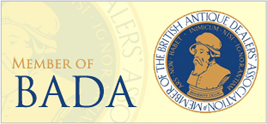| Steppes Hill Farm Antiques Newsletter #41 - January 2015 |
 |
May I first of all take this opportunity to wish you a very happy, peaceful and prosperous New Year from all of us at Steppes Hill Farm Antiques. Thank you for your custom during 2014 and we hope to be able to be of service again in 2015.
Secondly I would like to congratulate the winners of our Christmas Quiz Competition. The five lucky recipients of a Harrods Classic Christmas Puddings were: - Steve Daniels, Paul Dutnall, Glenn Hawksbee, Matthew Peppitt and Robin Butler.


Click on the above image to zoom
I have decided to base my first Newsletter of the year on a silver category that is becoming more and more prized by collectors and that is Novelty Silver Pepper Shakers modelled as animals or birds.
Before matching salt-and-pepper shakers became popular in the late Victorian era, better households offered their guests salt cellars (or salts, as they were also known) and pepper casters at the dining table. Salt cellars from the early part of the 18th century were round, rectangular, or octagonal in shape, usually with no feet. Later in the century, footed cellars with pierced sides were popular - a glass liner that fitted within the cellar kept the salt from spilling out. In those days, guests did not typically "pass the salt." Instead, salts were sold in sets, so that each guest might have his or her own, which was not a bad idea since salt was commonly applied to food with the fingers.
Casters were used for a number of spices, but they are most closely associated with pepper. So named because they allowed users to "cast" spices upon their food, casters had round bodies and domed tops, which were secured to the bodies with clasps. A variation on the caster was the pepper box, which accomplished the same thing as a caster but had squared-off sides and a handle.
By the 19th century, casters had won the design competition over cellars, as matching salt-and-pepper shakers that could be passed around the table from guest to guest became the dominant form. Some had ornately detailed feet and sides, with fussy finials at the top. Others were balanced on circular or square pedestals, and many antique sterling silver salt-and-pepper shakers were engraved with a family's monogram.
Of particular interest to collectors though are the novelty silver salt-and-pepper shakers from the Victorian era made in the form of animals or birds, often of very nice heavy quality cast construction, they have become very sought after indeed.

The photographs above illustrate a selection from our current stock and they can all be viewed on the web site in the 'Peppers Category'.

I am pleased to be able to start the new year off by updating the site this month with over 60 new items of stock and some highlights include; a rare Edwardian Silver Combination Butt Marker & Cartridge Extractor, an attractive pair of Art Deco Silver & Enamel Wine Labels for 'Italian & French', a nice quality Victorian Silver Gilt Rococo Sifter Spoon 'Diana The Huntress', a pair of Scottish Silver and enamel novelty Peppers formed as Dice, some Arts & Crafts style Caddy Spoons, a Victorian Novelty Silver Ship's Starboard Lantern Table Lighter, a pristine George III Silver Gilt Crested Snuff Box and several new additions to the Stamp Box Category.

Please make sure and check out the latest articles in our Blog, for all the latest news in the silver world and some other interesting features

I do hope that you will find this Newsletter informative and helpful and will allow us send it to you on a regular basis. I would welcome any feedback you may have, both positive and negative.
David W.A. Buck.
Steppes Hill Farm Antiques |
|

 |
 |
|

